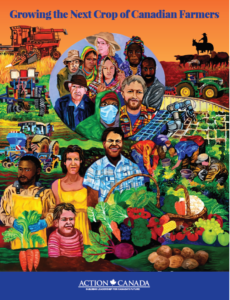
Growing the Next Crop of Canadian Farmers
An Action Canada ReportA central challenge to increase sustainability is the looming agricultural labour shortage, a problem that was on the rise long before the pandemic. Simply put, there are not enough farmers. There is a lot at stake. With the right investments in workforce capacity, skills and retention, the sector is well positioned to see an $11 billion increase in outputs by 2030. However, this can only happen if we bring new farmers into the fold. How might we create a more sustainable and resilient Canadian agricultural sector by reducing barriers for new-entrant farmers, with a particular focus on addressing barriers for populations who are traditionally underrepresented in farming, such as women, visible minorities, immigrants, youth and Indigenous Peoples?
We identified barriers to entry across four thematic areas: access to capital, land, knowledge and labour. Recognizing the complex and unique nature of farming in different parts of the country, we narrowed our focus to three agricultural regions: Saskatchewan, British Columbia and Quebec. Each province provided an opportunity to highlight scalable place-based approaches to supporting new farmers on the west coast, in the prairies, and in eastern Canada.
We need to reimagine a more sustainable and resilient future of agriculture that can meet Canada’s needs. To achieve this, Canada needs an integrated strategy to address the distinct barriers experienced by new entrant farmers. We offer the following recommendations in the spirit of building a robust service continuum for this group:
- Increase accessibility of programs and services.
- Lower barriers to capital to stimulate growth.
- Protect land to increase affordability for new entrants.
- Transfer knowledge to build capacity.
- Improve farmer work to retain and attract skilled labour.
- Invest in local sustainable food systems to revitalize rural economies.









